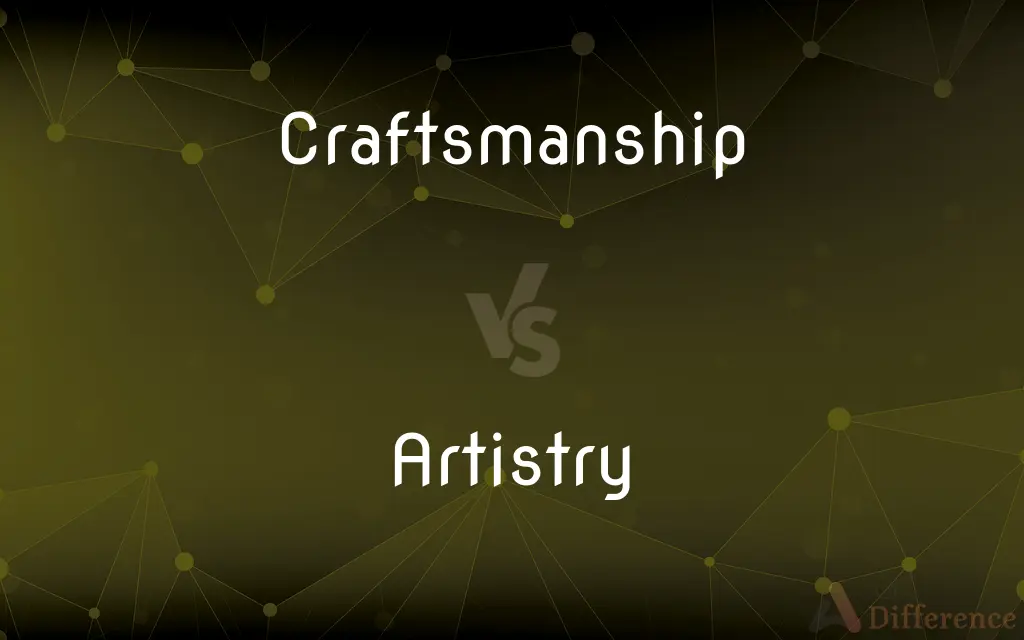Craftsmanship vs. Artistry — What's the Difference?
By Tayyaba Rehman — Published on October 5, 2023
Craftsmanship refers to the skill and quality put into creating a functional object. Artistry is the creative skill and imagination used in producing works primarily meant to be appreciated for their beauty or emotional power.

Difference Between Craftsmanship and Artistry
Table of Contents
ADVERTISEMENT
Key Differences
Craftsmanship is a term that often refers to the high level of skill and precision used in the creation of a functional item, like furniture or machinery. It focuses on the technical aspects, ensuring that the item not only looks good but also serves its intended purpose effectively. Artistry, on the other hand, leans towards the aesthetic and emotional aspects of creation, prioritizing the expressive or conceptual over the functional.
In craftsmanship, the value often lies in the utility and durability of the final product. An artisan craftsman aims for perfection in form and function, utilizing specialized tools and techniques. In contrast, artistry is about capturing an emotion, idea, or essence, sometimes without concern for utility. Artists often prioritize originality and innovation over functionality.
From a grammatical standpoint, both "craftsmanship" and "artistry" are nouns. They are rarely used as verbs, and both can be used as adjectives in compound forms like "craftsman-like" or "artistic." While craftsmanship implies a focus on skill and technique, artistry places emphasis on creativity and vision.
Both craftsmanship and artistry can coexist in the same piece of work. For instance, a beautifully crafted piece of furniture may exhibit high craftsmanship in its construction and artistry in its design. However, the two terms still delineate different aspects: craftsmanship speaks to the "how" of creation, whereas artistry addresses the "why."
Comparison Chart
Core Meaning
Skill in creating functional objects
Creative skill in aesthetic works
ADVERTISEMENT
Focus
Utility and durability
Beauty and emotional power
Grammatical Role
Primarily a noun
Primarily a noun
Connotation
Technical and practical
Creative and imaginative
End Goal
Functional perfection
Expressive or conceptual impact
Compare with Definitions
Craftsmanship
Attention to detail in making utilitarian items.
The fine craftsmanship made the pocket watch a collector's item.
Artistry
Skill in creating works of aesthetic or emotional value.
The artistry in her paintings left everyone awestruck.
Craftsmanship
Expertise in creating something with a specific purpose.
The craftsmanship in the machine parts was exceptional.
Artistry
Creative flair in artistic endeavors.
His artistry on the piano was mesmerizing.
Craftsmanship
Skill in creating functional, high-quality objects.
The craftsmanship in the handmade table was evident.
Artistry
Imagination in producing artistic works.
The sculpture showcased her artistry.
Craftsmanship
Technical skill in making something practical.
The craftsmanship in the ship's construction ensured its durability.
Artistry
Ability to convey emotion or ideas through art.
The film director's artistry was evident in every scene.
Craftsmanship
Mastery of a craft or trade.
His craftsmanship as a carpenter was unparalleled.
Artistry
Expressiveness in artistic creation.
The dancer's artistry was captivating.
Craftsmanship
A man who practices a craft with great skill.
Artistry
Artistic ability
A sculptor of great artistry.
Craftsmanship
The quality of being a craftsman.
Artistry
Artistic quality or craft
The artistry of a poem.
Craftsmanship
An example of a craftsman's work.
The craftsmanship on the antique chair was exquisite.
Artistry
Significant artistic skill.
Craftsmanship
The work of a craftsman.
Artistry
Works of art collectively.
Craftsmanship
Skill in an occupation or trade
Artistry
Artistic effect or quality.
Artistry
Artistic pursuits; artistic ability.
Artistry
A superior skill that you can learn by study and practice and observation;
The art of conversation
It's quite an art
Common Curiosities
Is Craftsmanship limited to physical objects?
Craftsmanship is commonly associated with physical objects but can extend to digital creations as well.
Can Artistry be functional?
While artistry focuses on aesthetics, it can incorporate functionality.
What is Craftsmanship?
Craftsmanship refers to the skill and precision in creating functional objects.
What is Artistry?
Artistry is the creative skill in producing aesthetic or emotionally powerful works.
Is Craftsmanship a type of Artistry?
Craftsmanship and artistry are related but distinct, with craftsmanship emphasizing function and artistry emphasizing form.
What types of jobs involve Craftsmanship?
Jobs like carpentry, watchmaking, and blacksmithing involve high levels of craftsmanship.
Can Craftsmanship be self-taught?
Many craftsmen are self-taught, although formal apprenticeships are common.
Is Craftsmanship always utilitarian?
Craftsmanship often prioritizes utility and durability but can also be aesthetically pleasing.
Is Artistry innate?
While some believe artistry can be innate, many artists undergo formal training.
Can Craftsmanship and Artistry coexist in one work?
Yes, a single piece can exhibit both craftsmanship in its construction and artistry in its design.
Can Craftsmanship evolve into Artistry?
With enough skill and creativity, craftsmanship can indeed evolve into artistry.
Can you be trained in Craftsmanship?
Yes, craftsmanship often involves specialized training in techniques and tools.
Does Artistry require formal education?
Formal education can enhance artistry but is not always required.
What's the primary focus of Artistry?
The primary focus of artistry is often beauty, originality, and emotional expression.
What professions are considered to involve Artistry?
Professions like painting, music composition, and filmmaking are often associated with artistry.
Share Your Discovery

Previous Comparison
Availability vs. Unavailability
Next Comparison
Publicity vs. Public RelationsAuthor Spotlight
Written by
Tayyaba RehmanTayyaba Rehman is a distinguished writer, currently serving as a primary contributor to askdifference.com. As a researcher in semantics and etymology, Tayyaba's passion for the complexity of languages and their distinctions has found a perfect home on the platform. Tayyaba delves into the intricacies of language, distinguishing between commonly confused words and phrases, thereby providing clarity for readers worldwide.
















































